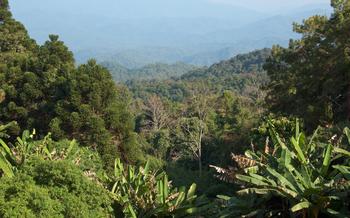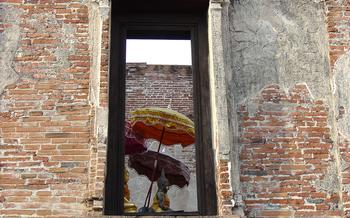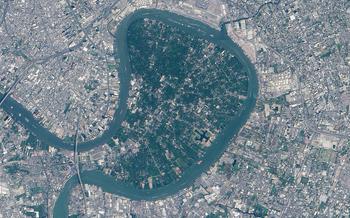
Wat Kao Kob Cave
- The Cave's Interior
- The Cave's Legends
- The Cave's Shrine
- Things to Do at Wat Kao Kob Cave
- Tips for Visiting Wat Kao Kob Cave
- Nearby Attractions
- Getting There
- Where to Stay
- Where to Eat
- When to Visit
- History of Wat Kao Kob Cave
- Wat Kao Kob Cave in Popular Culture
- Insider Tip
The Cave's Interior
The interior of Wat Kao Kob Cave is a sight to behold. The cave is adorned with a myriad of stalactites and stalagmites, which have been formed over thousands of years by the dripping of water from the cave's ceiling. These formations come in a variety of shapes and sizes, and they create a truly magical atmosphere within the cave. In addition to the stalactites and stalagmites, the cave is also home to a number of Buddha images and other religious artifacts. These artifacts have been placed in the cave by Buddhist pilgrims over the centuries, and they add to the cave's spiritual significance.
The Cave's Legends
Wat Kao Kob Cave is shrouded in mystery and legend. One of the most popular legends is the tale of the tiger. According to the legend, a fierce tiger once terrorized the local villagers. One day, a brave monk entered the cave and confronted the tiger. After a long battle, the monk emerged victorious and the tiger was banished from the cave.
Another legend tells the story of a beautiful princess who was kidnapped by a giant. The princess was imprisoned in the cave, but she was eventually rescued by a brave prince. The prince and princess then lived happily ever after in the kingdom.
The most sacred legend of all is the legend of the Buddha's footprint. According to the legend, the Buddha once visited the cave and left his footprint on a rock. The footprint is now a popular pilgrimage site for Buddhists from all over the world.
The Cave's Shrine
The cave's shrine is located in the deepest chamber of the cave. It is dedicated to the Buddha and contains several Buddha images, as well as other religious artifacts. The shrine is a popular place for pilgrims to make offerings and pray.
The Importance of the Shrine
The shrine is an important place for Buddhists, as it is believed to be the place where the Buddha rested after a long journey. It is also believed that the shrine has the power to grant wishes. Many people come to the shrine to pray for good luck, health, and prosperity.
Offerings Made at the Shrine
The most common offerings made at the shrine are flowers, candles, and incense sticks. People also often make offerings of food and money. The offerings are a way to show gratitude to the Buddha and to ask for his blessings.
Things to Do at Wat Kao Kob Cave
Wat Kao Kob Cave offers a range of activities for visitors to enjoy. Exploring the cave's interior is a must-do, allowing you to marvel at the intricate stalactites and stalagmites, as well as the Buddha images and other religious artifacts. Pay homage at the cave's shrine, a sacred site for locals and pilgrims alike. Offerings of flowers, candles, and incense are made to the shrine in hopes of good luck and blessings.
For a more relaxed experience, take some time to relax in the cave's surroundings. The Sala Kaew Kuha pavilion, situated near the cave entrance, offers stunning views of the surrounding landscape. Alternatively, take a boat tour of the surrounding area, allowing you to explore the hidden coves and inlets that dot the coastline.
Whether you're seeking adventure, spirituality, or simply a chance to unwind in nature, Wat Kao Kob Cave has something to offer everyone. Immerse yourself in the beauty and history of this sacred site, and create memories that will last a lifetime.
Tips for Visiting Wat Kao Kob Cave
Visiting Wat Kao Kob Cave can be a rewarding and inspiring experience, but it's essential to follow a few tips to ensure you have a safe and enjoyable visit:
-
Comfortable shoes: The cave's floor is uneven and can be slippery, so it's important to wear comfortable shoes with good traction.
-
Flashlight: The cave's interior is dark, so bringing a flashlight is essential to navigate safely and see the cave's features clearly.
-
Respectful of the cave's religious significance: Wat Kao Kob Cave is a sacred place for Buddhists, so visitors should be respectful of the religious significance of the site. Avoid loud noises and disruptive behavior, and be mindful of the monks and other visitors who may be praying or meditating.
-
Monkeys: The cave is home to a population of monkeys, which can be playful but also aggressive if they feel threatened. Avoid feeding the monkeys or making sudden movements, and keep your distance to prevent any unwanted encounters.
Nearby Attractions
Wat Kao Kob Cave is located in the Trang Province of Thailand, which is known for its stunning natural beauty. There are several other attractions in the area that are worth visiting.
One of the most popular nearby attractions is the Tham Phra Nang Cave. This cave is located on the Railay peninsula and is known for its beautiful stalactites and stalagmites. It is also a popular spot for rock climbing.
Another popular attraction is the Emerald Cave. This cave is located on Koh Mook Island and is only accessible at low tide. Inside the cave, you will find a beautiful lagoon with crystal clear water.
Finally, Railay Beach is a must-visit for anyone visiting Trang. This beach is known for its white sand, clear water, and stunning cliffs. It is a great place to relax and enjoy the scenery.
Getting There
Reaching Wat Kao Kob Cave is a breeze, with multiple transportation options available.
By Car: Embark on a scenic road trip, enjoying the picturesque landscapes along the way. Simply follow the signs leading to the cave, ensuring a hassle-free arrival.
By Bus: Hop on a convenient bus that will take you directly to the cave's entrance. Buses depart regularly from Trang town, offering a budget-friendly and comfortable journey.
By Boat: For a truly unique experience, take a boat tour from Trang town to the cave. This option allows you to admire the stunning coastal scenery and arrive at the cave's entrance by water.
Where to Stay
Wat Kao Kob Cave is located in a relatively remote area, but there are a number of accommodation options available nearby. If you're looking for a place to stay that's close to the cave, your best options are the Wat Kao Kob Guesthouse and the Phraya Trang Hotel. Both of these guesthouses offer basic but comfortable rooms at affordable prices.
If you're looking for something a little more luxurious, you may want to consider staying at the Trang Resort Hotel. This hotel is located about 10 kilometers from the cave, but it offers a wider range of amenities, including a swimming pool, a restaurant, and a spa.
No matter where you choose to stay, be sure to book your room in advance, especially if you're visiting during the peak season.
Where to Eat
Wat Kao Kob Cave is surrounded by several local restaurants offering delicious Thai cuisine. Whether you prefer to dine in or take away, you'll find plenty of options to satisfy your palate.
One of the most popular dishes in the area is Khao Soi, a northern Thailand specialty consisting of egg noodles in a rich and flavorful curry sauce, often served with chicken or beef. Another must-try is Pad Thai, a stir-fried rice noodle dish with shrimp, chicken or tofu and a tangy tamarind sauce.
For seafood lovers, the Tom Yum Goon is a must-order. This spicy and sour soup features succulent shrimp in a fragrant broth made with lemongrass, galangal, and kaffir lime leaves.
If you have a sweet tooth, don't miss the Mango Sticky Rice, a classic Thai dessert made with sweet, ripe mango and sticky rice topped with coconut cream.
No matter what your taste buds crave, you're sure to find something to your liking at the restaurants near Wat Kao Kob Cave. Be sure to try some of the local specialties for an authentic Thai dining experience.
When to Visit
The best time to visit Wat Kao Kob Cave is during the dry season, which runs from November to April. During this time, the weather is cool and dry, making it ideal for exploring the cave's interior. The cave is also less crowded during this time, so you'll be able to enjoy a more peaceful and intimate experience.
The rainy season, which runs from May to October, can be a bit more challenging to visit the cave. The trails can be slippery and muddy, and the cave can be more crowded with tourists. However, the lush greenery and waterfalls that surround the cave during this time can be quite beautiful.
If you're planning to visit the cave during the rainy season, be sure to wear sturdy shoes and bring a raincoat or umbrella. You should also be aware that the cave may be closed during periods of heavy rain.
History of Wat Kao Kob Cave
Wat Kao Kob Cave holds immense religious significance in Thailand. It is believed to have been a sacred site since ancient times, with evidence suggesting that it was used for religious purposes as early as the 5th century AD. During the reign of King Rama V, the cave was designated as a royal temple and became a popular destination for pilgrims and tourists alike.
The cave's religious significance is further enhanced by the presence of several Buddha images and other religious artifacts, including a large reclining Buddha that is said to date back to the 13th century. These artifacts, coupled with the cave's natural beauty, have made Wat Kao Kob Cave a popular destination for both religious and secular visitors.
Wat Kao Kob Cave in Popular Culture
Wat Kao Kob Cave has gained recognition in popular culture, capturing the attention of filmmakers and television producers. Its unique and visually stunning features have made it an ideal backdrop for various productions. The cave has appeared in several movies and TV shows, showcasing its natural beauty and cultural significance.
These appearances have further popularized the cave, attracting tourists who are eager to experience the same awe-inspiring scenes they saw on screen. The cave's presence in popular culture has also contributed to its preservation and recognition as a valuable cultural heritage site.
One of the most notable appearances of Wat Kao Kob Cave was in the 2010 movie "The Hangover Part II." The cave served as a key location in the film, where the characters embark on a wild adventure. The movie's portrayal of the cave's stunning interiors and its use as a setting for thrilling scenes helped to introduce it to a global audience.
Wat Kao Kob Cave has also been featured in several Thai TV shows and documentaries, highlighting its religious and cultural significance. These productions have provided viewers with an in-depth look into the cave's history, legends, and rituals, further fueling interest in this remarkable natural wonder.
The cave's popularity in popular culture has undoubtedly contributed to its status as a must-visit destination in Trang. Its unique beauty and cultural significance have captured the imagination of people worldwide, making it a sought-after location for filmmakers and tourists alike.
Insider Tip
-
A secret spot for taking photos of the cave: For the best photos of Wat Kao Kob Cave, head to the nearby Sala Kaew Kuha pavilion. This elevated viewpoint offers stunning panoramic views of the cave's entrance, framed by lush tropical greenery. From here, you can capture the cave's majestic beauty without the crowds.
-
A less-crowded time to visit the cave: To avoid the crowds and fully appreciate the cave's tranquility, plan your visit for a weekday morning. During the off-season (May to October), you'll likely have the cave almost to yourself, allowing you to immerse yourself in its spiritual ambiance without distractions.






